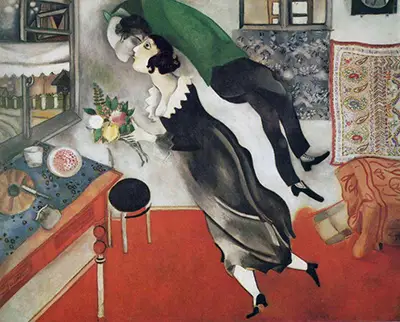This piece exudes the joy of their much celebrated love less than three weeks before the couple’s marriage took place. An oil painting on cardboard, it is currently owned by New York City’s the Museum of Modern Art (MoMA) although it is not currently on exhibition.
Early in Chagall’s adulthood, he made the difficult decision of leaving Bella in their native Vitebsk (in modern day Belarus) in 1911 to further his career.
He had received money from one of his patrons, the local politician Maxim Binaver, who encouraged the young painter to explore his talents within the artistic community in Paris, France. In 1914, he traveled to Berlin for his first solo exhibition, and then decided to return briefly to Vitebsk. Fate intervened, the Great War broke out, and Chagall was unable to return to Paris.
Several accounts of Chagall’s life reveal that he had been concerned that Bella might choose not to marry him after his extended stay in France. She was very young and her family had misgivings about her impending marriage to Marc who was not her social equal.
She came from a wealthy family who made its fortune in jewels, and Marc was very poor. All accounts, including her memoir many years later, indicate that their feelings for one another were uniquely strong. In fact, all of his art surrounding the time of his marriage seems infused with the theme of her and his feelings of elation for her.
An early modernist who was clearly influenced by cubism and fauvism, Chagall’s Birthday presents the fantastical imprint of his own colourful imagination. His love visited him that day in his studio bearing flowers and food as a celebration.
There can be no mistaking his reaction to her arrival. As if in a dream and wearing her characteristic white and/or black, Bella floats above the floor as Marc soars in affection, bending back rather unnaturally to kiss her.
The vibrancy of the reds and blues and green of the painting capture the ecstasy of his emotions for Bella. In fact, Chagall referred to love as the primary source of all colour within his paintings.
It is a bliss that can not be contained by drabness or gravity. Bella was his muse and their romance was often his inspiration. Her visit to wish him a happy birthday that day in July 1915 has resulted in a joy that, through artistic expression, has outlived both of them.
They were married for 29 years until Bella’s death of an infection in 1944. Together they faced the Nazi threat in Europe and along with their daughter were sponsored to migrate to the United States by the MoMA since Jewish artists were a particular target of Hitler’s. It was here where Bella died. Marc married two more times, but his euphoric love for Bella endured.
